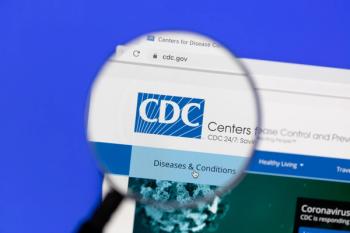
Nipocalimab, a monoclonal antibody targeting maternal alloantibodies, has received FDA Breakthrough Therapy Designation for treating severe hemolytic disease of the fetus and newborn.

Nipocalimab, a monoclonal antibody targeting maternal alloantibodies, has received FDA Breakthrough Therapy Designation for treating severe hemolytic disease of the fetus and newborn.

Uncover the impact of maternal pre-pregnancy BMI on perinatal outcomes as elucidated by a multi-study investigation, shedding light on strategies to mitigate obstetric and neonatal risks through weight management.

A study revealed a correlation between maternal cortisol levels, stress, and adverse birth outcomes, shedding light on potential implications for perinatal health.

Disparities in prenatal care and missed opportunities for diagnosis highlight the need for innovative approaches to tackle the rising prevalence of congenital syphilis, emphasizing standardized screening, higher quality diagnostics, and therapeutic interventions.

A recent study highlighted how racial disparities, exacerbated by structural racism, impact the administration of neuraxial analgesia during labor, underscoring the need for interventions to address social inequity in maternal health care access.

A recent report from the Centers for Disease Control and Prevention outlined methods of detecting syphilis in patients, including nontreponemal tests, treponemal tests, and nonspecific antibodies.

A recent study found that transgender women with HIV face elevated risks of bacterial sexually transmitted infections, emphasizing the need for tailored interventions and further research to address the distinct challenges faced by this population.

A recent study found that the Gardasil quadrivalent HPV vaccine effectively shields HIV-positive adolescents from high-risk HPV types 16, 18, 6, and 11, shedding light on the potential for HPV vaccination to mitigate cancer risks in this vulnerable population.

Explore the Center for Disease Control of Prevention’s latest report on sexually transmitted infections, emphasizing the critical need for prioritizing STIs in public health.

Hologic's Genius Digital Diagnostics System, the first FDA-cleared digital cytology system using AI and advanced imaging, promises improved sensitivity in detecting pre-cancerous lesions and cervical cancer cells.

Review some of the top stories from the Contemporary OB/GYN website over the last week, and catch up on anything you may have missed.

Uncover the latest findings on contraceptive methods as researchers delve into the safety, efficacy, and compliance rates of parenteral and oral hormonal contraceptives.

Preliminary findings suggest The Guardians mobile app, blending gaming and behavioral activation techniques, could be a solution for alleviating perinatal depression among pregnant women.

A phase 3 trial demonstrated that oteseconazole (VIVJOA; Mycovia Pharmaceuticals) capsules exhibit improved therapeutic and mycological cure rates to fluconazole for treating severe vulvovaginal candidiasis.

A systematic review of 6 studies revealed that COVID-19 vaccination during pregnancy does not significantly increase the risk of preterm birth, providing crucial insights for public health policies and offering reassurance to healthcare providers and expectant mothers.

A recent study revealed a 2-dose regimen of human papillomavirus vaccination in postpartum individuals is as effective as a 3-dose approach, providing valuable insights into optimizing vaccination strategies against the virus.

Dive into the latest research in metabolomics and proteomics, revealing potential biomarkers like fibrinogen cleavage peptides and GRAM domain-containing protein 1C, offering new avenues for diagnosis and treatment in addressing the global issue of female infertility.

New findings have revealed a decline in emergency contraception-related emergency department visits, indicating increased demand.

A recent study revealed that early postpartum administration of dexmedetomidine significantly reduces the risk of postpartum depression among women with prenatal depression.

A recent study revealed the aftermath of the Dobbs decision, with college students expressing anger and fear, facing pressure to switch to effective contraception.

Explore the potential of monoclonal antibodies for contraception and sexually transmitted infection prevention, providing a comprehensive review of their safety, efficacy, and pharmacokinetics.

A recent study unveiled the sustained safety and efficacy of relugolix combination therapy over 2 years.

Review some of the top stories from the Contemporary OB/GYN website over the last week, and catch up on anything you may have missed.

Explore the relationship between bacterial vaginosis and vulvovaginal candidiasis as revealed by a recent study, uncovering mixed interactions, antibiotic implications, and the potential role of vaginal microbiota in shaping this complex association.

A recent study challenged the hypothesis of maternal stress during pregnancy as a significant risk factor for ischemic heart disease and stroke in younger patients, shedding light on the nuanced relationship between prenatal stress and cardiovascular health.

A recent study indicated perinatal depression significantly increases the risk of suicidal behavior, particularly within the first year post-diagnosis, emphasizing the need for targeted interventions in this vulnerable population.

A recent study revealed that the Nurse-Family Partnership's infant and toddler home visits significantly decrease obesity and hypertension risks in mothers and female offspring, emphasizing the potential cost-saving impact on physical health outcomes.

A recent study revealed that patients with 3 or more COVID-19 vaccination doses exhibit a significant increase in cord anti-Spike antibody levels compared to those with 2 doses.

A recent study revealed that infants exposed to buprenorphine during the first trimester exhibit a significantly decreased risk of developing congenital malformations associated with opioid exposure compared to infants exposed to methadone.

The Biden-Harris administration, has released comprehensive guidance through Frequently Asked Questions to eliminate barriers to contraception, ensuring access to FDA-approved contraceptives at no cost, following President Biden's 2023 Executive Order.